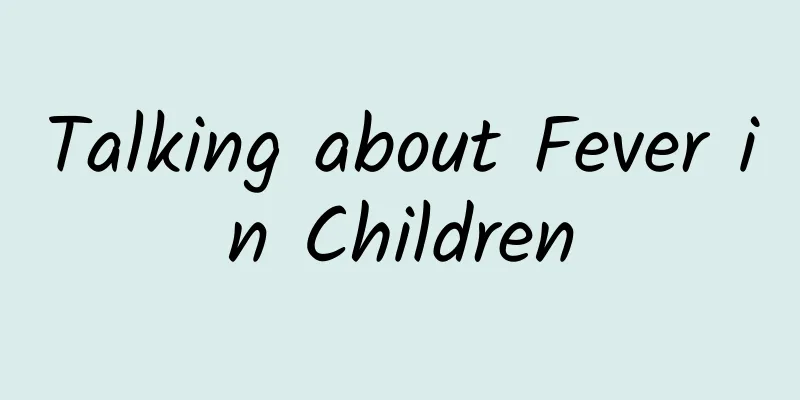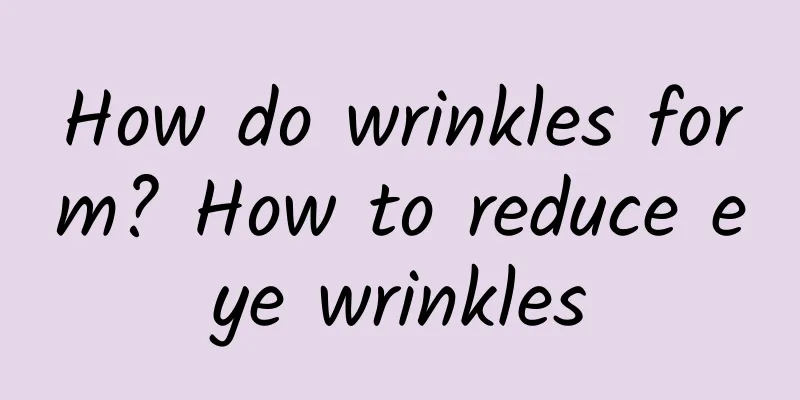Talking about Fever in Children

|
Fever in children is one of the most common symptoms in pediatrics, accounting for more than 50% of pediatric emergencies. Parents generally have a phobia of children's fever. Once a child has a fever, they are at a loss, worried that the fever will burn the brain or cause convulsions. Some parents give their children antipyretics as soon as they find that the temperature exceeds 37℃, and some rush to the hospital for injections and infusions. In fact, there are many misunderstandings here. Today we will share with you the information and medication knowledge related to children's fever, hoping to help you. 1. What is fever? Fever refers to the body temperature rising beyond the normal range when the body temperature is affected by pyrogens or various reasons cause dysfunction of the body temperature regulation center. In other words, when the body temperature rises beyond the upper limit of normal body temperature fluctuations in a day, we call it fever. In clinical work, rectal temperature ≥38℃ or axillary temperature ≥37.5℃ is usually defined as fever. Of course, ear temperature and forehead temperature are also measured now. We generally think that it is considered a fever if it exceeds 37.5℃. Children are prone to fever when they are sick, but fever does not necessarily mean that they are sick, because the temperature of children is affected by many factors, such as feeding, exercise, crying, overdressing, etc., which may temporarily increase the temperature of children to 37.5℃, especially newborns or infants are more susceptible to these conditions. If the child's temperature is only temporarily elevated, as long as the general condition is good, you can observe for a period of time. But when the child's temperature is higher than 38℃, it is necessary to find the cause in time. 2. Does a higher temperature mean a more serious condition? It is unscientific to predict the severity of a disease based solely on body temperature. A high fever does not necessarily mean that the disease is serious. Low fever or the temporary use of antipyretics may also be effective in reducing fever, but there is also a risk of serious bacterial infection. The correlation between high temperature and disease severity is not that close, and its clinical value in predicting disease severity is also limited. Studies have shown that when the body temperature of patients under 6 months old exceeds 39°C, it is more valuable in predicting serious diseases, especially in patients under 3 months old. In other words, the younger the age, the greater the significance of this prediction. 3. Is fever harmful to the body? Will it damage the brain? Fever itself is the body's natural response to resist pathogens. It is a protective response that can promote the maturation of the immune system and enhance immune function. There is currently insufficient evidence to prove that fever is harmful to the body. Fever alone will not affect the brain. However, some diseases with fever symptoms, such as typhoid fever, tuberculosis, encephalitis and meningitis, may have potential effects on the central nervous system. If not treated in time, they will damage brain cells and cause certain damage to intelligence. It is these diseases that damage the brain, not the fever that burns the brain. In addition, in clinical practice, some metabolic diseases may also cause damage to the brain and nervous system without fever. 4. Since fever itself is harmless to the body but beneficial, why do we need to actively reduce fever? First, as the body temperature rises, the child's basal metabolic rate will also increase. Therefore, when the child is in a fever state, the child's consumption of sugar, fat, protein and various vitamins will increase. If the child has a long-term fever without the corresponding nutrition supplement, the child will consume his own substances and lose weight or become emaciated. At the same time, due to the evaporation of a large amount of water or sweating during fever, a large amount of water will be lost. In severe cases, it can cause dehydration and electrolyte imbalance, and even endanger life. Secondly, fever can increase the excitability of the central nervous system, especially when the fever is high, the child may experience irritability, delirium, hallucinations, etc. Because the nervous system of children is not yet fully developed, especially in infancy, febrile convulsions are more likely to occur. In addition, fever may be accompanied by other symptoms, such as lack of energy, depression, difficulty eating, muscle aches and other uncomfortable feelings, and antipyretics are needed to relieve these symptoms. It can also be said that the purpose of antipyretic is to increase the comfort of children. 5. What are the misunderstandings about physical cooling to treat fever? Just now we said that fever itself will not lead to worsening of the disease or damage to the nervous system. The main purpose of our antipyretic treatment is to improve the comfort of the child, rather than just focusing on whether the body temperature has dropped to normal. However, many parents and friends generally have some misunderstandings about the antipyretic treatment methods. For example, it is very incorrect to use alcohol or ice water sponge baths, quilts to cover sweat, etc. Although the use of alcohol or ice water sponge baths can temporarily reduce the body surface temperature, it will also cause the child to shiver, goose bumps and other uncomfortable feelings, and even cause the child to cry, so it is not advisable. Similarly, wrapping the child tightly with clothes and quilts to force sweat out will also make the child more uncomfortable. At this time, the child's clothes should be loosened, the window should be opened for ventilation, or the air conditioner should be turned on to maintain a cool temperature. You can also wipe the forehead with a warm water towel, use a fever patch, a fever blanket, etc. These methods can take away the body's heat through conduction, convection and evaporation, making the feverish child feel comfortable, so they can be used. 6. How to deal with fever correctly? When parents find that their children have a fever, they should first control their nervousness and give their children the most appropriate treatment as soon as possible. We can first measure the child's body temperature and make a preliminary judgment on the child's fever. There are four levels of fever based on axillary temperature: 37.5~38.0℃ is considered low fever; 38.1~38.9℃ is considered moderate heat; 39.0~40.9℃ is considered high fever; A temperature above 41°C is considered hyperthermia. If it is a low fever, you need to observe the child's appearance and mental state. If the child can eat, drink, play, and is full of energy, it means that the child's condition may not be serious. You can use the physical cooling method mentioned earlier, keep the air circulating at home, dress the child in thinner clothes, and supplement with an appropriate amount of water to speed up metabolism. When the axillary temperature is ≥38.2℃, antipyretics should be considered for children over 2 months old. Of course, if the child has headache, weakness in the limbs, depression, poor spirits, etc. during the low fever, even if the body temperature is not 38.2℃, antipyretics should still be considered. If the fever is high or above, parents should first take measures to cool the child down and immediately send the child to a medical institution for further treatment to prevent convulsions caused by high body temperature. In addition, for those with chronic diseases or serious illnesses or those with dysfunction of important organs, such as heart failure, respiratory failure, etc., fever can lead to an increased metabolic rate, increased burden or damage to organs, and worsening of the condition, so active cooling should be done. 7. What medicines can be chosen when children have fever? The World Health Organization and my country's guidelines recommend that there are only two antipyretic drugs for children: acetaminophen and ibuprofen. For children aged ≥ 2 months, acetaminophen can be used, and for children aged ≥ 6 months, either acetaminophen or ibuprofen can be used. Other drugs like nimesulide can cause liver and kidney damage and have been banned for use in children under 12 years old in 2011. Analgin and aspirin are not the first choice for children's fever reduction due to their serious side effects. Lysine aspirin is a complex salt of aspirin and lysine. It is prohibited for children under 3 months old and should be used with caution in children under 16 years old. Conclusion Fever is a manifestation of disease, a symptom rather than an independent disease. Therefore, children's fever cannot be simply reduced, and the cause of the fever should be actively sought. Children should not blindly take medication due to their special physiological functions. Using antipyretics too early and/or too much will not only increase the side effects of the drugs, but also affect the diagnosis of the disease. (Ding Xiangyu, Hebei Provincial Children's Hospital) |
<<: Your baby has a lot of phlegm when coughing. Do you know how to deal with it correctly?
Recommend
Does a normal birth require an episiotomy?
In modern society, many women choose caesarean se...
What is the way to relieve girls' black lips?
Lips are a very important part of people's fa...
Why can't we find any evidence of the existence of the Xia Dynasty?
The Xia Dynasty was the first hereditary dynasty ...
Why do I have back pain after a painless abortion?
Painless abortion is a popular method of abortion...
What are the maintenance measures for women during menopause?
Menopause is a watershed in the bodies of women. ...
Is it dangerous to have twins with one placenta?
During a woman's pregnancy, if one embryo is ...
Cervical erosion has a foul odor
A woman's uterus is actually a very fragile a...
What tests should I do if I find out I am pregnant?
Nowadays, eugenics is advocated. Before women wan...
Can I eat lemon curd during menstruation?
Lemon sauce is actually a lemon-flavored sauce. T...
Ovarian cancer takes several years to develop
In short, ovarian cancer is a cancerous disease t...
Why do I have pain on the right side during menstruation?
Many women around us have symptoms of abdominal p...
15 weeks pregnant, hard belly
For pregnant women, the most feared thing is the ...
What should I do if I feel bad and suffer from insomnia during the third month of pregnancy?
Many pregnant mothers have recently experienced m...
The national standard for pre-prepared dishes is here! Are you still worried about pre-prepared dishes?
Recently, the State Administration for Market Reg...









